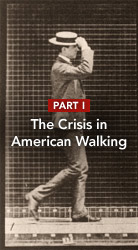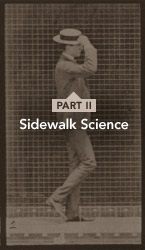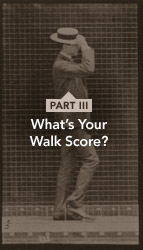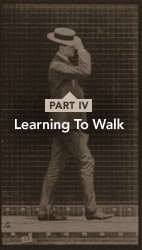The Crisis in American Walking
How we got off the pedestrian path.
A few years ago, at a highway safety conference in Savannah, Ga., I drifted into a conference room where a sign told me a “Pedestrian Safety” panel was being held.
The speaker was Michael Ronkin, a French-born, Swiss-raised, Oregon-based transportation planner whose firm, as his website notes, “specializes in creating walkable and bikeable streets.” Ronkin began with a simple observation that has stayed with me since. Taking stock of the event—one of the few focused on walking, which gets scant attention at traffic safety conferences—he wondered about that inescapable word: pedestrian. If we were to find ourselves out hiking on a forest trail and spied someone approaching at a distance, he wanted to know, would we think to ourselves, “Here comes a pedestrian”?
Of course we wouldn’t. That approaching figure would simply be a person. Pedestrian is a word born from opposition to other modes of travel; the Latin pedester, on foot, gained currency by its semantic tension with equester, on horse. But there is an implied—indeed, synonymous—pejorative. This dates from Ancient Greece. As the Oxford English Dictionary notes, the Greek πεζός meant “prosaic, plain, commonplace, uninspired (sometimes contrasted with the winged flight of Pegasus).” Or, in the Latin, pedester could refer to foot soldiers (e.g, peons), “rather than cavalry.”
In other words, not to be on a horse, flying or otherwise, was to be utterly unremarkable and mundane. To this day, Ronkin was intimating, the word pedestrian bears not only that slightly alien whiff, but the scars of condescension. This became clear as we walked later that evening through the historic center of Savannah. As we moved through the squares, our rambling trajectory matched by our expansive conversation, we were simply people doing that most human of things, walking. But every once in a while, we would encounter a busy thoroughfare, and we became pedestrians. We lurked under ridiculously large retroreflective signs, built not at our scale, but to be seen by those moving at a distance and at speed. Other signs reinforced the message, starkly announcing: “Stop for Pedestrians.” I thought, “Wait, who’s a pedestrian? Is that me?”
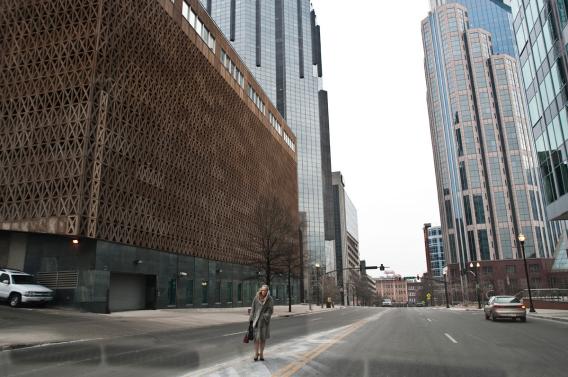
Photograph by Peter van Agtmael/Magnum Photos.
Simply by going out for a walk, I had become a strange being, studied by engineers, inhabiting environments whose physical features are determined by a rulebook-enshrined average 3 foot-per-second walking speed, my rights codified by signs. (Why not just write: “Stop for People”?) On those same signs in Savannah were often attached additional signs, advising drivers not to give to panhandlers (and to call 911 if physically intimidated), subtly equating walking with being exposed to an urban menace—or perhaps being the menace. Having taken all this information in, we would gingerly step into the marked crosswalk, that declaration of rights in paint, and try to gauge whether approaching vehicles would yield. They typically did not. Even in one of America’s most “pedestrian-friendly” cities—a seemingly innocent phrase that itself suddenly seemed strange to me—one was always in danger of being relegated to a footnote.
Which is what walking in America has become: An act dwelling in the margins, an almost hidden narrative running beneath the main vehicular text. Indeed, the semantics of the term pedestrian would be a mere curiosity, but for one fact: America is a country that has forgotten how to walk. Witness, for example, the existence of “Everybody Walk!,” the “Campaign to Get America Walking” (one of a number of such initiatives). While its aims are entirely legitimate, its motives no doubt earnest, the idea that that we, this species that first hoisted itself into the world of bipedalism nearly 4 million years ago—for reasons that are still debated—should now need “walking tips,” have to make “walking plans” or use a “mobile app” to “discover” walking trails near us or build our “walking histories,” strikes me as a world-historical tragedy.
For walking is the ultimate “mobile app.” Here are just some of the benefits, physical, cognitive and otherwise, that it bestows: Walking six miles a week was associated with a lower risk of Alzheimer’s (and I’m not just talking about walking in the “Walk to End Alzheimers”); walking can help improve your child’s academic performance; make you smarter; reduce depression; lower blood pressure; even raise one’s self-esteem.” And, most important, though perhaps least appreciated in the modern age, walking is the only travel mode that gets you from Point A to Point B on your own steam, with no additional equipment or fuel required, from the wobbly threshold of toddlerhood to the wobbly cusp of senility.
Despite these upsides, in an America enraptured by the cultural prosthesis that is the automobile, walking has become a lost mode, perceived as not a legitimate way to travel but a necessary adjunct to one’s car journey, a hobby, or something that people without cars—those pitiable “vulnerable road users,” as they are called with charitable condescension—do. To decry these facts—to examine, as I will in this series, how Americans might start walking more again— may seem like a hopelessly retrograde, romantic exercise: nostalgia for Thoreau’s woodland ambles. But the need is urgent. The decline of walking has become a full-blown public health nightmare.
***
The United States walks the least of any industrialized nation. Studies employing pedometers have found that where the average Australian takes 9,695 steps per day (just a few shy of the supposedly ideal “10,000 steps” plateau, itself the product, ironically, of a Japanese pedometer company’s campaign in the 1960s), the average Japanese 7,168, and the average Swiss 9,650, the average American manages only 5,117 steps. Where a child in Britain, according to one study, takes 12,000 to 16,000 steps per day, a similar U.S. study found a range between 11,000 and 13,000.
Why do we walk so comparatively little? The first answer is one that applies virtually everywhere in the modern world: As with many forms of physical activity, walking has been engineered out of existence. With an eye toward the proverbial grandfather who regales us with tales of walking five miles to school in the snow, this makes instinctive sense. But how do we know how much people used to walk? There were no 18th-century pedometer studies.
There are, however, proxies. One could, for example, study a group “whose lifestyle has not changed markedly in the last 150 years,” which is precisely what David Bassett and colleagues did, in a study published in Medicine & Science in Sports and Exercise. Equipping a Canadian group of Old Order Amish—who work in labor-intensive farming—with pedometers, the researchers found walking levels on the order of 18,000 steps per day (not to mention comparatively low obesity rates). And a study by Gary Egger, et al., in The Medical Journal of Australia compared the walking habits people who worked as actors portraying Australian settlers at a historical theme park near Sydney to those of a group of office workers. The re-enactors were 1.6 to 2.3 times more active than the cubicle dwellers. To your pitchforks!
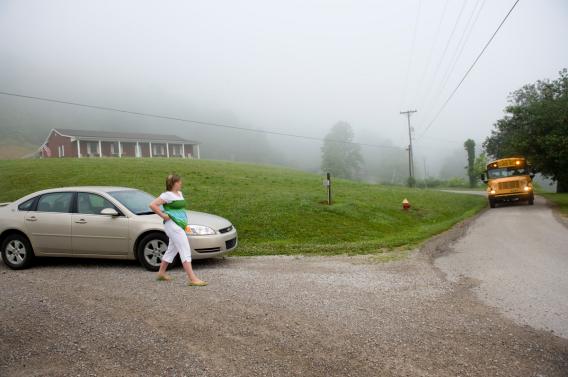
Photograph by Linda Davidson / The Washington Post via Getty Images.
If walking is a casualty of modern life the world over—the historian Joe Moran estimates, for instance, that in the last quarter century in the U.K., the amount of walking has declined by 25 percent—why then do Americans walk even less than people in other countries? Here we need to look not at pedometers, but at the odometer: We drive more than anyone else in the world. (Hence a joke: In America a pedestrian is someone who has just parked their car.) Statistics on walking are more elusive than those on driving, but from the latter one might infer the former: The National Household Travel Survey shows that the number of vehicle trips a person took and the miles they traveled per day rose from 2.32 trips and 20.64 miles in 1969 to 3.35 and 32.73 in 2001. More time spent driving means less time spent on other activities, including walking. And part of the reason we are driving more is that we are living farther from the places we need to go; to take just one measure, in1969, roughly half of all children lived a mile or more from their school; by 2001 three out of four did. During that same period, unsurprisingly, the rates of children walking to school dropped from roughly half to approximately 13 percent.
And since our uncommon commitment to the car is at least in part to blame for the new American inability to put one foot in front of the other, the transportation engineering profession’s historical disdain for the pedestrian is all that much more pernicious. In modern traffic engineering the word has become institutionalized, by engineers who shorten pedestrian to the somehow even more condescending “peds”; who for years have peppered their literature with phrases like “pedestrian impedance” (meaning people getting in the way of vehicle flow). In early versions of traffic modeling software, pedestrians were not included as a default, and even today, as one report notes, modeling software tends to treat them not as actual actors, but as a mere “statistical distribution”, or as implicit “vehicular delay.” At traffic conferences like the one in Savannah, meanwhile, people doing “ped projects” tend to be a small and insular, if well meaning, clique.
Another problem: Almost everyone walks. In this ubiquity, paradoxically, lies a weakness: The very act is so common that we tend to forget about it, to remember that it is something that needs to be nurtured, protected, encouraged. Save for charity drives and recreational enthusiasts, there are few organized groups of self-identified walkers. Craig Tackaberry, the associate director of public works in Marin County told me that when the county received a federal grant specifically designed to boost the number of people walking and cycling, they sought to partner with local advocacy groups. “It was difficult to find any pedestrian advocacy groups,” he says. Cyclists have elaborate equipment, they have passion, they have group rides and races—and they have political organizations. As Scott Bricker, director of the nonprofit organization America Walks told me, without a trace of irony in his voice, “Walking’s not something that people rally around — it’s very pedestrian.”
Perhaps as a result, walking is a pastime that’s not well studied. Walking in America is a bit like sex: Everybody’s doing it, but nobody knows how much. Bricker, of America Walks, adds that the “collection of information around walking is quite poor and inconsistent.” There are the problems of self-reporting—who can really remember, sans pedometer, how much one has walked, and who wants to admit on a survey that they never walk? There’s also little agreement, he says, on what, statistically, constitutes a walking trip. “Is walking down the hall to the bathroom a walking trip? Do you have to leave the house? Is walking to the park with your dog a walking trip? Is walking to and from the bus a walking trip? None of those things are counted.” The most accurate source of information we have comes from the U.S. Census, in the so-called “Journey to Work” questions. But these only inquire about commuting trips. What’s more, as researchers have noted, because the Census emphasizes the mode of transportation taken most often, and for the longest part of the total journey, any number of walking trips may be obscured. People who take train transit, for example, have been shown in pedometer studies to walk much more than those who drive.
This focus on work trips rather misses the point in a country where very few people could walk to work, even if they wanted. Commuting (by any method) accounts for less than 15 percent of all trips. What’s more at stake is so-called “discretionary travel,” the trips to the grocery store, to soccer practice, to the bank, and these are where we logged our greatest increases in driving. “It’s not just about how many people walk to work,” says Bricker. “It’s how many are willing to walk out the front door for any reason.” Where walking has been lost is in these short trips of a mile or less—28 percent of all trips in America—the majority of which are now taken in a car. “Let’s take that stroll,” says Bricker. “It’s missing from the cultural mindset.”
***
In her book Wanderlust: A History of Walking, Rebecca Solnit writes, “walking still covers the ground between cars and buildings and the short distances within the latter, but walking as a cultural activity, as a pleasure, as travel, as a way of getting around, is fading, and with it goes an ancient and profound relationship between body, world, and imagination.” There is at once a loss, and a hunger. Look on online travelers forums and you’ll see one of the most common threads is people on the verge of visiting Europe (or New York City), embarking on a panicked quest for “walking shoes”—as if they were taking up some exotic new sport, procuring strange equipment. For these people, one must assume, walking is as foreign as the place they are visiting. (N.B.: I have lived in New York City, the most-walked city in the U.S., for more than two decades and have never owned a pair of Merrells.)
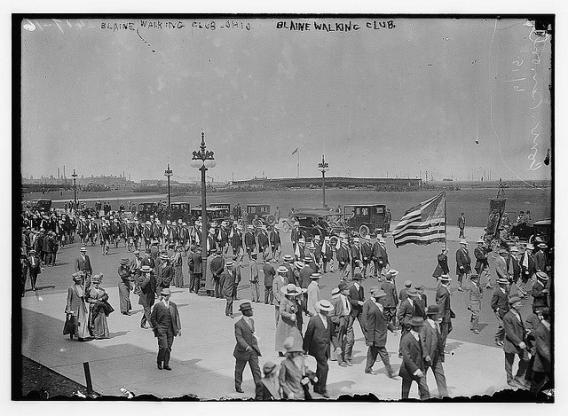
Photograph courtesy Bain News Service/Library of Congress.
Walking has become a boutique pastime: There is frantic weekend power-walking (making up for the week’s lack of locomotion); there is the ostentatiously lo-fi commute (observes Geoff Manaugh: “people now think the very act of walking around makes them a kind of psychogeographic avant-garde”); there is walking-centric conceptual art; and there are stylized, idealized, walkable “lifestyle centers” which themselves must be driven to (if you’re lucky, you’ll find one with an indoor “panoramic walking track”), where walking itself is as vaguely antique as the iron lamp-posts and cobble-stones. The writer Will Self, a dedicated walker, well captured the sense that the pedestrian life is one so removed from daily consciousness that to participate in it implies some higher purpose. “Whenever I tell people I’m going to walk somewhere utilitarian—like an airport; or even a long distance walk that seems quite prosaic to me, they always ask: ‘Is it for charity?’ ”
This question—what is walking for—is one of the many I will be exploring this week. There is a dual pedagogical imperative here: I aim to explore not only how people on foot behave as a class, but also how America lost its knack for walking, only now taking some stumbling steps in the right direction. The newspapers have been filled of late, from coast to coast, from suburban Arizona to the Midwest to rural Mississippi, with a strikingly uniform narrative, couched in words like “sustainability” and “accessibility” but revolving around a simple appeal: Residents asking that their towns be made more walkable. The almost Onion-worthy headline of one story, “Columbus residents see potential benefits of sidewalks,” with that poisonous modifier “potential,” hints at how far off the trail of common sense America has wandered in its headlong pursuit of the automotive life.
Along the way, I will walk the streets of New York City with pedestrian experts, explore the curious patterns of mass pedestrian behavior, travel to the Seattle offices of “Walk Score,” a Web startup that is quantifying “walkability,” and then look at what happened to walking in America—and how we can put our right foot forward.
More from this series: What scientists learn when they study pedestrians; how Walk Score has put a number on walkability; how America can get people walking again.
